.url(url)
.build();
builder.build().newCall(request).enqueue(new Callback() {
@Override
public void onFailure(Call call, IOException e) {}
@Override
public void onResponse(Call call, Response response) throws IOException {}
});
}
请求操作的起点从 OkHttpClient.newCall().enqueue() 方法开始
OkHttpClient.newCall
@Override public Call newCall(Request request) {
return RealCall.newRealCall(this, request, false /* for web socket */);
}
RealCall.newRealCall.java
static RealCall newRealCall(OkHttpClient client, Request originalRequest, boolean forWebSocket) {
// Safely publish the Call instance to the EventListener.
RealCall call = new RealCall(client, originalRequest, forWebSocket);
call.transmitter = new Transmitter(client, call);
return call;
}
这个方法会返回一个 RealCall 对象,通过它将网络请求操作添加到请求队列中。
RealCall.enqueue
@Override public void enqueue(Callback responseCallback) {
synchronized (this) {
if (executed) throw new IllegalStateException(“Already Executed”);
executed = true;
}
transmitter.callStart();
client.dispatcher().enqueue(new AsyncCall(responseCallback));
}
client.dispatcher()返回Dispatcher,调用 Dispatcher 的 enqueue 方法,执行一个异步网络请求的操作。
Dispatcher 是 OkHttpClient 的调度器,是一种门户模式。主要用来实现执行、取消异步请求操作。本质上是内部维护了一个线程池去执行异步操作,并且在 Dispatcher 内部根据一定的策略,保证最大并发个数、同一 host 主机允许执行请求的线程个数等。
Dispatcher.enqueue
void enqueue(AsyncCall call) {
synchronized (this) {
readyAsyncCalls.add(call);
if (!call.get().forWebSocket) {
AsyncCall existingCall = findExistingCallWithHost(call.host());
if (existingCall != null) call.reuseCallsPerHostFrom(existingCall);
}
}
promoteAndExecute();
}
实际上就是使用线程池执行了一个 AsyncCall,而 AsyncCall 继承了 NamedRunnable,NamedRunnable 实现了 Runnable 接口,因此整个操作会在一个子线程(非 UI 线程)中执行。
NamedRunnable
/**
* Runnable implementation which always sets its thread name.
*/
public abstract class NamedRunnable implements Runnable {
protected final String name;
public NamedRunnable(String format, Object… args) {
this.name = Util.format(format, args);
}
@Override public final void run() {
String oldName = Thread.currentThread().getName();
Thread.currentThread().setName(name);
try {
execute();
} finally {
Thread.currentThread().setName(oldName);
}
}
protected abstract void execute();
}
在 run 方法中执行了 一个抽象方法 execute 这个抽象方法被 AsyncCall 实现。
AsyncCall.execute
@Override protected void execute() {
boolean signalledCallback = false;
transmitter.timeoutEnter();
try {
Response response = getResponseWithInterceptorChain();
signalledCallback = true;
responseCallback.onResponse(RealCall.this, response);
} catch (IOException e) {
if (signalledCallback) {
// Do not signal the callback twice!
Platform.get().log(INFO, "Callback failure for " + toLoggableString(), e);
} else {
responseCallback.onFailure(RealCall.this, e);
}
} finally {
client.dispatcher().finished(this);
}
}
从上面看出而真正获取请求结果的方法是在 getResponseWithInterceptorChain 方法中,从名字也能看出其内部是一个拦截器的调用链。
RealCall.getResponseWithInterceptorChain
Response getResponseWithInterceptorChain() throws IOException {
// Build a full stack of interceptors.
List interceptors = new ArrayList<>();
interceptors.addAll(client.interceptors());
interceptors.add(new RetryAndFollowUpInterceptor(client));
interceptors.add(new BridgeInterceptor(client.cookieJar()));
interceptors.add(new CacheInterceptor(client.internalCache()));
interceptors.add(new ConnectInterceptor(client));
if (!forWebSocket) {
interceptors.addAll(client.networkInterceptors());
}
interceptors.add(new CallServerInterceptor(forWebSocket));
Interceptor.Chain chain = new RealInterceptorChain(interceptors, transmitter, null, 0,
originalRequest, this, client.connectTimeoutMillis(),
client.readTimeoutMillis(), client.writeTimeoutMillis());
boolean calledNoMoreExchanges = false;
try {
Response response = chain.proceed(originalRequest);
if (transmitter.isCanceled()) {
closeQuietly(response);
throw new IOException(“Canceled”);
}
return response;
} catch (IOException e) {
calledNoMoreExchanges = true;
throw transmitter.noMoreExchanges(e);
} finally {
if (!calledNoMoreExchanges) {
transmitter.noMoreExchanges(null);
}
}
}
Interceptor:拦截器是一种强大的机制,可以监视、重写和重试调用。
每一个拦截器的作用如下:
-
BridgeInterceptor:主要对 Request 中的 Head 设置默认值,比如 Content-Type、Keep-Alive、Cookie 等。
-
CacheInterceptor:负责 HTTP 请求的缓存处理。
-
ConnectInterceptor:负责建立与服务器地址之间的连接,也就是 TCP 链接。
-
CallServerInterceptor:负责向服务器发送请求,并从服务器拿到远端数据结果。
-
RetryAndFollowUpInterceptor:此拦截器从故障中恢复,并根据需要执行重定向。如果呼叫被取消,它可能会引发IOException。
在添加上述几个拦截器之前,会调用 client.interceptors 将开发人员设置的拦截器添加到列表当中。
对于 Request 的 Head 以及 TCP 链接,我们能控制修改的成分不是很多。所以咱们了解 CacheInterceptor 和 CallServerInterceptor。
CacheInterceptor 缓存拦截器
======================
CacheInterceptor 主要做以下几件事情:
1、根据 Request 获取当前已有缓存的 Response(有可能为 null),并根据获取到的缓存 Response,创建 CacheStrategy 对象。
2、 通过 CacheStrategy 判断当前缓存中的 Response 是否有效(比如是否过期),如果缓存 Response 可用则直接返回,否则调用 chain.proceed() 继续执行下一个拦截器,也就是发送网络请求从服务器获取远端 Response。
3、如果从服务器端成功获取 Response,再判断是否将此 Response 进行缓存操作。
CacheInterceptor.intercept
@Override public Response intercept(Chain chain) throws IOException {
//根据 Request 获取当前已有缓存的 Response(有可能为 null),并根据获取到的缓存 Response
Response cacheCandidate = cache != null
? cache.get(chain.request())
: null;
//获取当前时间
long now = System.currentTimeMillis();
//创建 CacheStrategy 对象
//通过 CacheStrategy 来判断缓存是否有效
CacheStrategy strategy = new CacheStrategy.Factory(now, chain.request(), cacheCandidate).get();
Request networkRequest = strategy.networkRequest;
Response cacheResponse = strategy.cacheResponse;
if (cache != null) {
cache.trackResponse(strategy);
}
if (cacheCandidate != null && cacheResponse == null) {
closeQuietly(cacheCandidate.body()); // The cache candidate wasn’t applicable. Close it.
}
//如果我们被禁止使用网络,并且缓存不足,则失败。返回空相应(Util.EMPTY_RESPONSE)
if (networkRequest == null && cacheResponse == null) {
return new Response.Builder()
.request(chain.request())
.protocol(Protocol.HTTP_1_1)
.code(504)
.message(“Unsatisfiable Request (only-if-cached)”)
.body(Util.EMPTY_RESPONSE)
.sentRequestAtMillis(-1L)
.receivedResponseAtMillis(System.currentTimeMillis())
.build();
}
// 如果缓存有效,缓存 Response 可用则直接返回
if (networkRequest == null) {
return cacheResponse.newBuilder()
.cacheResponse(stripBody(cacheResponse))
.build();
}
//没有缓存或者缓存失败,则发送网络请求从服务器获取Response
Response networkResponse = null;
try {
//执行下一个拦截器,networkRequest
//发起网络请求
networkResponse = chain.proceed(networkRequest);
} finally {
//如果我们在I/O或其他方面崩溃,请不要泄漏cache body。
if (networkResponse == null && cacheCandidate != null) {
closeQuietly(cacheCandidate.body());
}
}
。。。
//通过网络获取最新的Response
Response response = networkResponse.newBuilder()
.cacheResponse(stripBody(cacheResponse))
.networkResponse(stripBody(networkResponse))
.build();
//如果开发人员有设置自定义cache,则将最新response缓存
if (cache != null) {
if (HttpHeaders.hasBody(response) && CacheStrategy.isCacheable(response, networkRequest)) {
// Offer this request to the cache.
CacheRequest cacheRequest = cache.put(response);
return cacheWritingResponse(cacheRequest, response);
}
//返回response(缓存或网络)
return response;
}
通过 Cache 实现缓存功能
通过上面缓存拦截器的流程可以看出,OkHttp 只是规范了一套缓存策略,但是具体使用何种方式将数据缓存到本地,以及如何从本地缓存中取出数据,都是由开发人员自己定义并实现,并通过 OkHttpClient.Builder 的 cache 方法设置。
OkHttp 提供了一个默认的缓存类 Cache.java,我们可以在构建 OkHttpClient 时,直接使用 Cache 来实现缓存功能。只需要指定缓存的路径,以及最大可用空间即可,如下所示:
OkHttpClient.Builder builder = new OkHttpClient.Builder();
builder.connectTimeout(15, TimeUnit.SECONDS)//设置超时
拦截器
.addInterceptor(new Interceptor() {
@Override
public Response intercept(Chain chain) throws IOException {
return null;
}
})
//设置代理
.proxy(new Proxy(Proxy.Type.HTTP,null))
//设置缓存
//AppGlobalUtils.getApplication() 通过反射得到Application实例
//getCacheDir内置 cache 目录作为缓存路径
//maxSize 1010241024 设置最大缓存10MB
.cache(new Cache(AppGlobalUtils.getApplication().getCacheDir(),
1010241024));
Cache 内部使用了 DiskLruCach 来实现具体的缓存功能,如下所示:
/**
* Create a cache of at most {@code maxSize} bytes in {@code directory}.
*/
public Cache(File directory, long maxSize) {
this(directory, maxSize, FileSystem.SYSTEM);
}
Cache(File directory, long maxSize, FileSystem fileSystem) {
this.cache = DiskLruCache.create(fileSystem, directory, VERSION, ENTRY_COUNT, maxSize);
}
DiskLruCache 最终会将需要缓存的数据保存在本地。如果感觉 OkHttp 自带的这套缓存策略太过复杂,我们可以设置使用 DiskLruCache 自己实现缓存机制。
LRU:是近期最少使用的算法(缓存淘汰算法),它的核心思想是当缓存满时,会优先淘汰那些近期最少使用的缓存对象。采用LRU算法的缓存有两种:LrhCache和DisLruCache,分别用于实现内存缓存和硬盘缓存,其核心思想都是LRU缓存算法。
CallServerInterceptor 详解
========================
CallServerInterceptor 是 OkHttp 中最后一个拦截器,也是 OkHttp 中最核心的网路请求部分。
CallServerInterceptor.intercept
@Override public Response intercept(Chain chain) throws IOException {
//获取RealInterceptorChain
RealInterceptorChain realChain = (RealInterceptorChain) chain;
//获取Exchange
Exchange exchange = realChain.exchange();
Request request = realChain.request();
long sentRequestMillis = System.currentTimeMillis();
exchange.writeRequestHeaders(request);
boolean responseHeadersStarted = false;
Response.Builder responseBuilder = null;
if (HttpMethod.permitsRequestBody(request.method()) && request.body() != null) {
if (“100-continue”.equalsIgnoreCase(request.header(“Expect”))) {
exchange.flushRequest();
responseHeadersStarted = true;
exchange.responseHeadersStart();
responseBuilder = exchange.readResponseHeaders(true);
}
if (responseBuilder == null) {
if (request.body().isDuplex()) {
exchange.flushRequest();
BufferedSink bufferedRequestBody = Okio.buffer(
exchange.createRequestBody(request, true));
request.body().writeTo(bufferedRequestBody);
} else {
// Write the request body if the “Expect: 100-continue” expectation was met.
BufferedSink bufferedRequestBody = Okio.buffer(
exchange.createRequestBody(request, false));
request.body().writeTo(bufferedRequestBody);
bufferedRequestBody.close();
自我介绍一下,小编13年上海交大毕业,曾经在小公司待过,也去过华为、OPPO等大厂,18年进入阿里一直到现在。
深知大多数初中级Android工程师,想要提升技能,往往是自己摸索成长或者是报班学习,但对于培训机构动则近万的学费,着实压力不小。自己不成体系的自学效果低效又漫长,而且极易碰到天花板技术停滞不前!
因此收集整理了一份《2024年Android移动开发全套学习资料》,初衷也很简单,就是希望能够帮助到想自学提升又不知道该从何学起的朋友,同时减轻大家的负担。
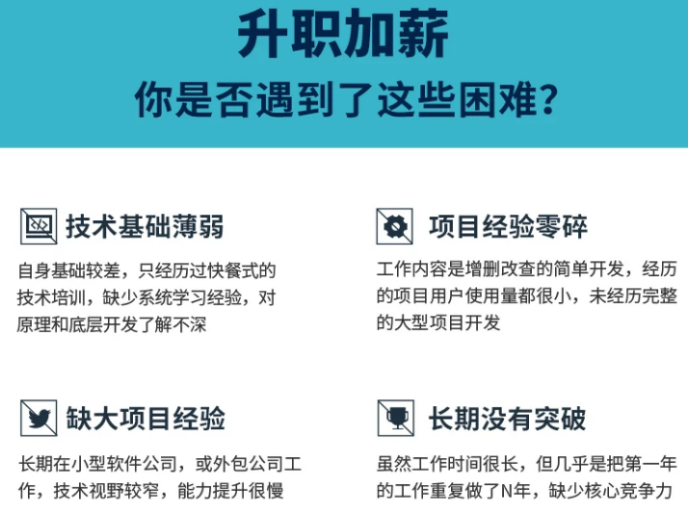
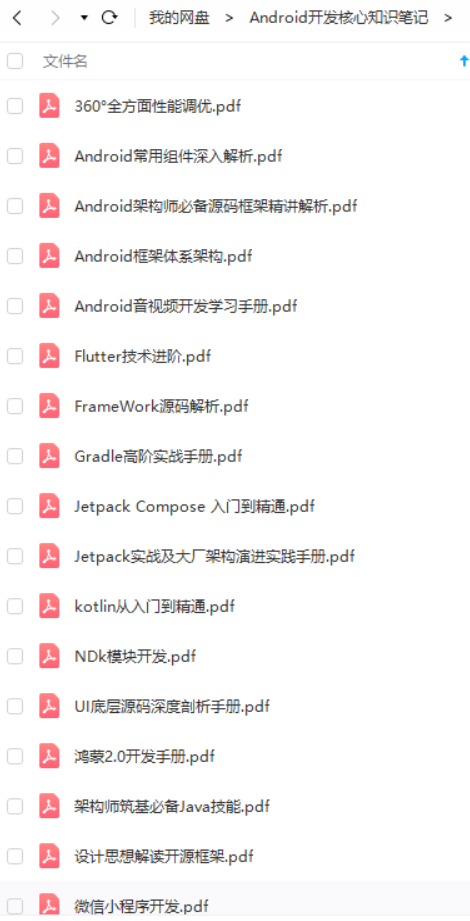
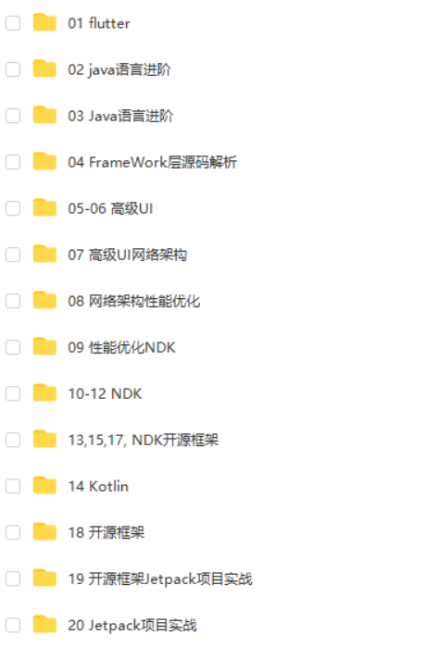
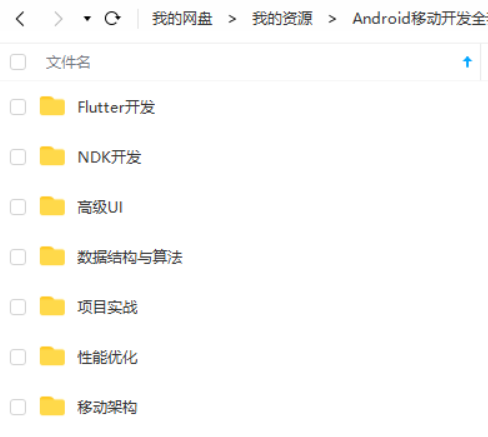
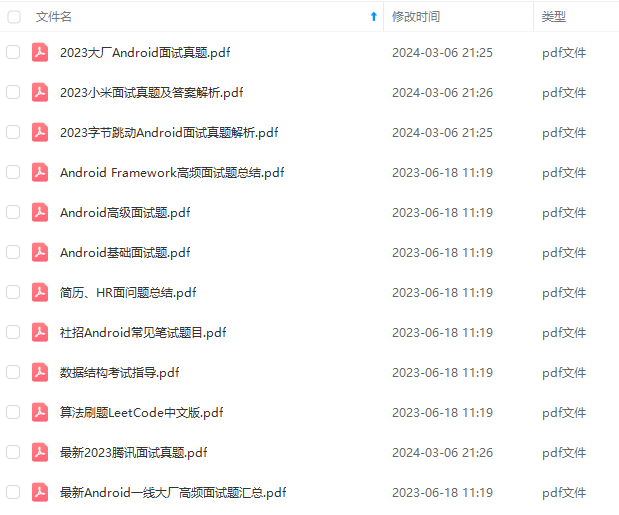
既有适合小白学习的零基础资料,也有适合3年以上经验的小伙伴深入学习提升的进阶课程,基本涵盖了95%以上Android开发知识点,真正体系化!
由于文件比较大,这里只是将部分目录截图出来,每个节点里面都包含大厂面经、学习笔记、源码讲义、实战项目、讲解视频,并且会持续更新!
如果你觉得这些内容对你有帮助,可以扫码获取!!(备注:Android)

结语
看到这篇文章的人不知道有多少是和我一样的Android程序员。
35岁,这是我们这个行业普遍的失业高发阶段,这种情况下如果还不提升自己的技能,进阶发展,我想,很可能就是本行业的职业生涯的终点了。
我们要有危机意识,切莫等到一切都成定局时才开始追悔莫及。只要有规划的,有系统地学习,进阶提升自己并不难,给自己多充一点电,你才能走的更远。
千里之行始于足下。这是上小学时,那种一元钱一个的日记本上每一页下面都印刷有的一句话,当时只觉得这句话很短,后来渐渐长大才慢慢明白这句话的真正的含义。
有了学习的想法就赶快行动起来吧,不要被其他的事情牵绊住了前行的脚步。不要等到裁员时才开始担忧,不要等到面试前一晚才开始紧张,不要等到35岁甚至更晚才开始想起来要学习要进阶。
给大家一份系统的Android学习进阶资料,希望这份资料可以给大家提供帮助。

《互联网大厂面试真题解析、进阶开发核心学习笔记、全套讲解视频、实战项目源码讲义》点击传送门即可获取!
,也有适合3年以上经验的小伙伴深入学习提升的进阶课程,基本涵盖了95%以上Android开发知识点,真正体系化!**
由于文件比较大,这里只是将部分目录截图出来,每个节点里面都包含大厂面经、学习笔记、源码讲义、实战项目、讲解视频,并且会持续更新!
如果你觉得这些内容对你有帮助,可以扫码获取!!(备注:Android)
[外链图片转存中…(img-eANB1L1j-1713721785145)]
结语
看到这篇文章的人不知道有多少是和我一样的Android程序员。
35岁,这是我们这个行业普遍的失业高发阶段,这种情况下如果还不提升自己的技能,进阶发展,我想,很可能就是本行业的职业生涯的终点了。
我们要有危机意识,切莫等到一切都成定局时才开始追悔莫及。只要有规划的,有系统地学习,进阶提升自己并不难,给自己多充一点电,你才能走的更远。
千里之行始于足下。这是上小学时,那种一元钱一个的日记本上每一页下面都印刷有的一句话,当时只觉得这句话很短,后来渐渐长大才慢慢明白这句话的真正的含义。
有了学习的想法就赶快行动起来吧,不要被其他的事情牵绊住了前行的脚步。不要等到裁员时才开始担忧,不要等到面试前一晚才开始紧张,不要等到35岁甚至更晚才开始想起来要学习要进阶。
给大家一份系统的Android学习进阶资料,希望这份资料可以给大家提供帮助。
[外链图片转存中…(img-l7j65Jrf-1713721785145)]
《互联网大厂面试真题解析、进阶开发核心学习笔记、全套讲解视频、实战项目源码讲义》点击传送门即可获取!






















 1353
1353

 被折叠的 条评论
为什么被折叠?
被折叠的 条评论
为什么被折叠?








